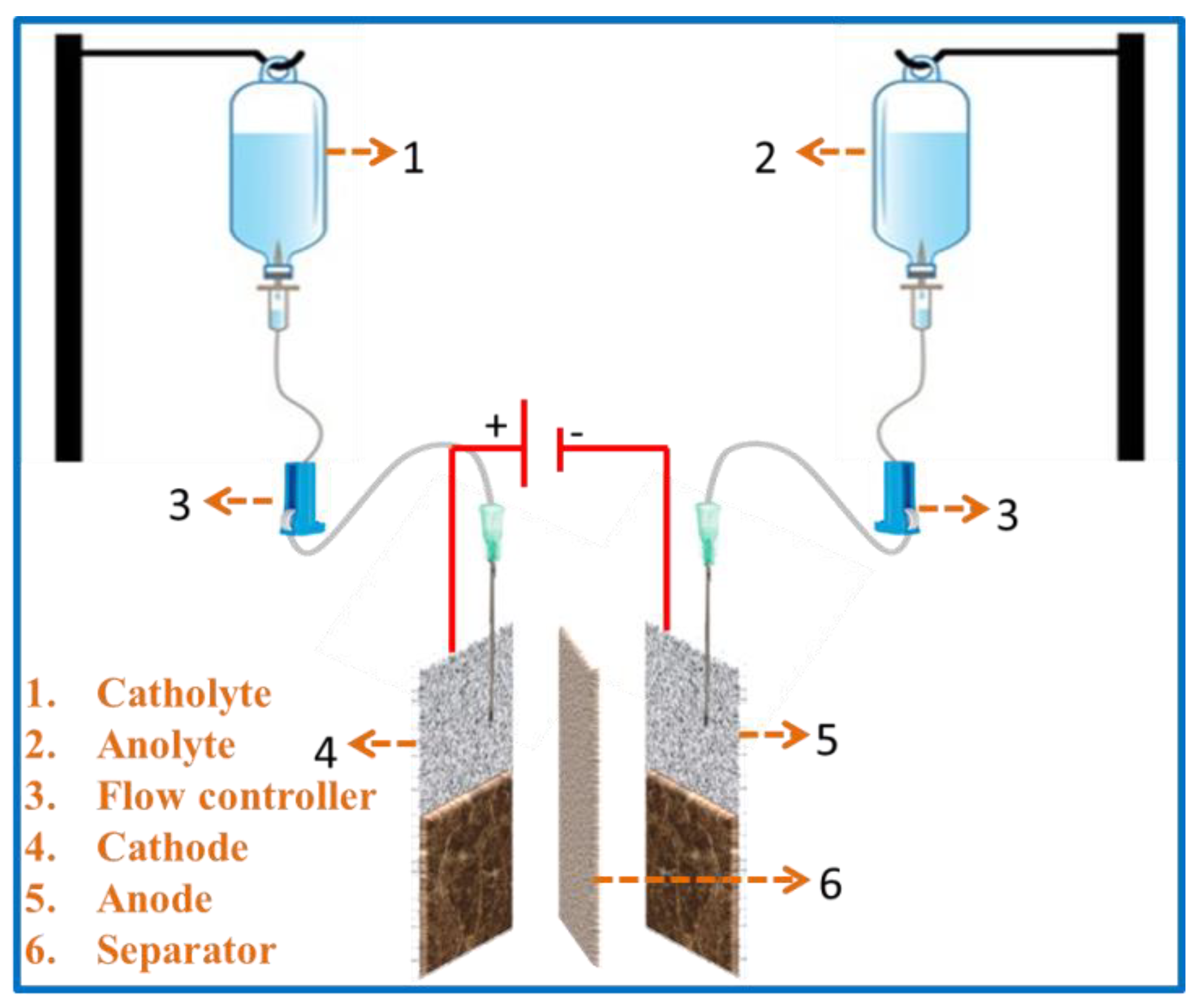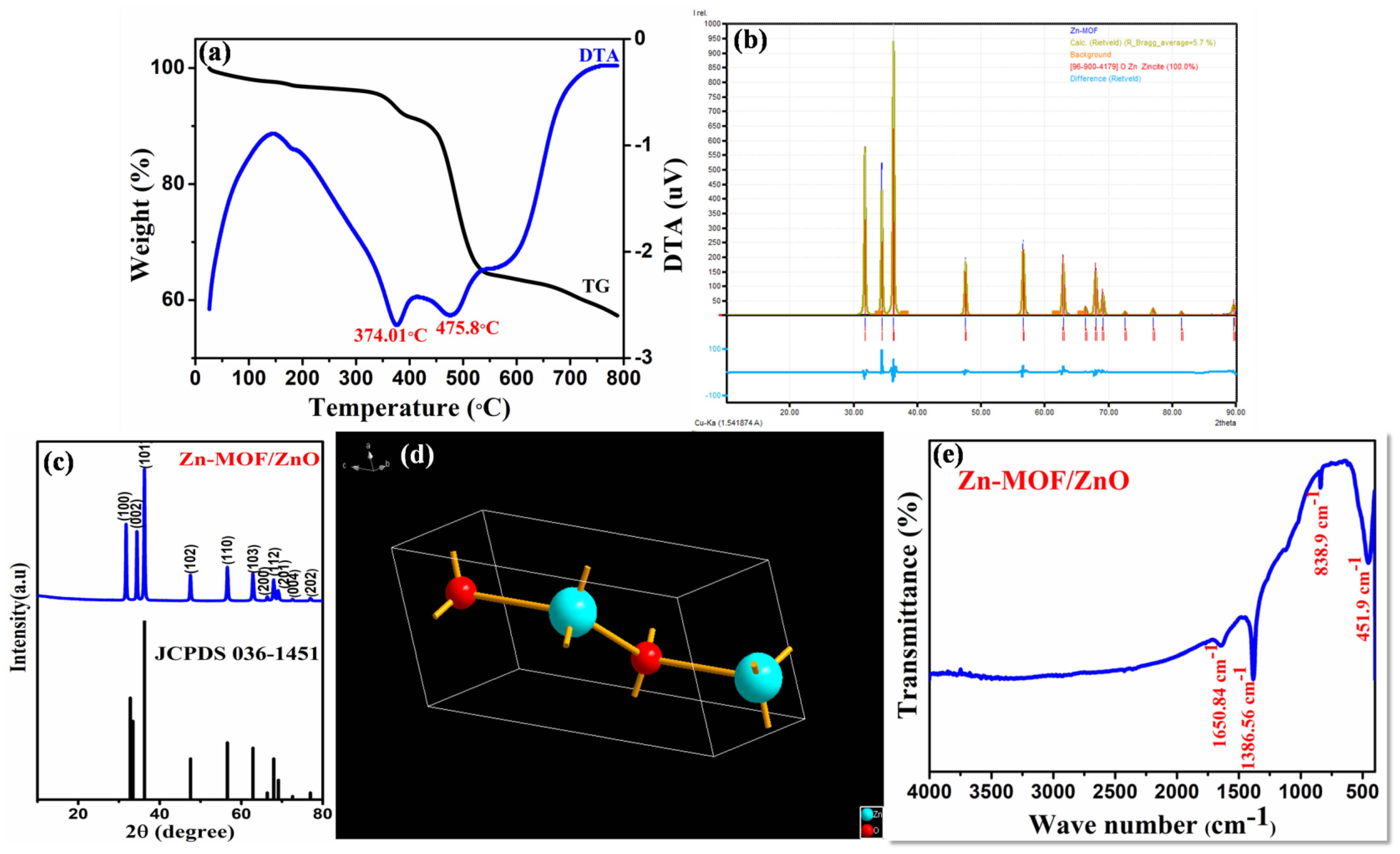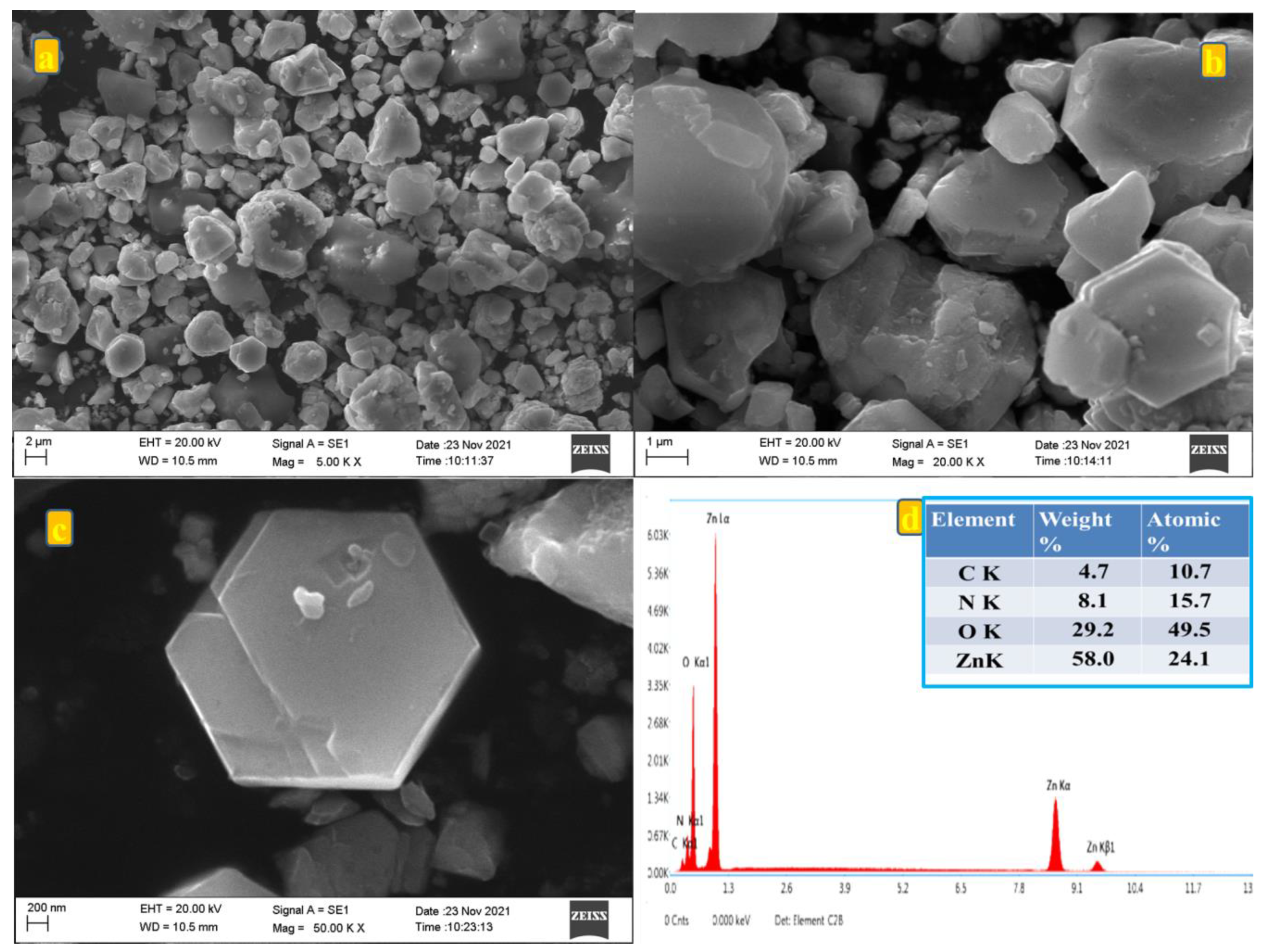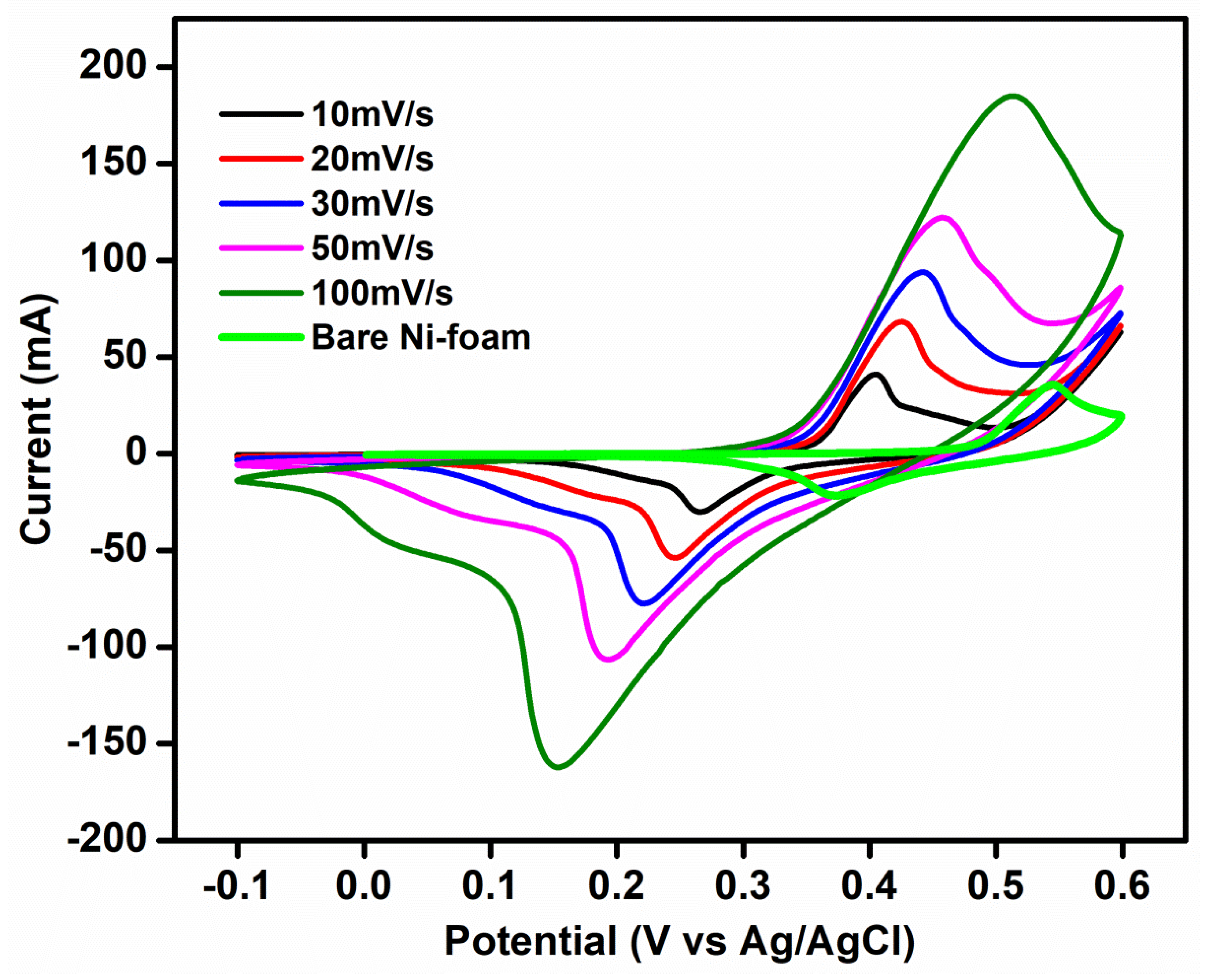Turning Trash to Treasure: Reusable Glucose Kit as a Cell Using ZnO Derived from Metal Organic Framework (MOF) Electrode for Redox Flow Battery
Abstract
:1. Introduction
2. Materials and Methods
2.1. Synthesis of Zn-MOF/ZnO
2.2. Preparation of Working Electrode
2.3. Preparation of Electrolyte
2.4. Characterization Techniques
2.5. Electrochemical Characterizations
2.6. Describing Materials
2.7. Engineering Aspects and Working of the Redox Flow Battery Using Glucose Kit as a Flow Cell
3. Results
3.1. TG/DTA Analysis
3.2. XRD Analysis
3.3. FT-IR Analysis
3.4. FE-SEM Analysis
3.5. Brunauer-Emmett-Teller Analysis
3.6. XPS Analysis
4. Discussions
4.1. Electrochemical Studies
4.2. Flow Test
5. Conclusions
Supplementary Materials
Author Contributions
Funding
Data Availability Statement
Conflicts of Interest
References
- Muruganantham, R.; Sivakumar, M.; Subadevi, R. Synthesis and electrochemical characterization of olivine-type lithium iron phosphate cathode materials via different techniques. Ionics 2016, 22, 1557–1565. Available online: https://link.springer.com/article/10.1007/s11581-016-1676-3 (accessed on 22 May 2022). [CrossRef]
- Rajkumar, P.; Diwakar, K.; Subadevi, R.; Gnanamuthu, R.M.; Sivakumar, M. Sulfur cloaked with different carbonaceous materials for high performance lithium sulfur batteries. Curr. Appl. Phys. 2019, 19, 902–909. [Google Scholar] [CrossRef]
- Li, L.; Kim, S.; Wang, W.; Vijayakumar, M.; Nie, Z.; Chen, B.; Zhang, J.; Xia, G.; Hu, J.; Graff, G.; et al. A stable vanadium redox-flow battery with high energy density for large-scale energy storage. Adv. Energy Mater. 2011, 1, 394–400. [Google Scholar] [CrossRef]
- Deng, Q.; Huang, P.; Zhou, W.X.; Ma, Q.; Zhou, N.; Xie, H.; Ling, W.; Zhou, C.J.; Yin, Y.X.; Wu, X.W.; et al. A High-Performance Composite Electrode for Vanadium Redox Flow Batteries. Adv. Energy Mater. 2017, 7, 1700461. [Google Scholar] [CrossRef]
- Zeng, Y.K.; Zhou, X.L.; An, L.; Wei, L.; Zhao, T.S. A high-performance flow-field structured iron-chromium redox flow battery. J. Power Sources 2016, 324, 738–744. [Google Scholar] [CrossRef]
- Sun, X.; Yao, S.; Zhao, Q.; Zhao, Y.; Cheng, J. Simulation Modeling and Charge–Discharge Characteristics of a Zinc–Nickel Single-Flow Battery Stack. Int. J. Electrochem. Sci. 2020, 15, 651–665. [Google Scholar] [CrossRef]
- Li, B.; Liu, J.; Nie, Z.; Wang, W.; Reed, D.; Liu, J.; Mc Grail, P.; Sprenkle, V. Metal–organic frameworks as highly active electrocatalysts for high-energy density, aqueous zinc-polyiodide redox flow batteries. Nano Lett. 2016, 16, 4335–4340. [Google Scholar] [CrossRef]
- Amini, K.; Gostick, J.; Pritzker, M.D. Metal and metal oxide electrocatalysts for redox flow batteries. Adv. Funct. Mater. 2020, 30, 1910564. [Google Scholar] [CrossRef]
- Cheng, J.; Zhang, L.; Yang, Y.S.; Wen, Y.H.; Cao, G.P.; Wang, X.D. Preliminary study of single flow zinc–nickel battery. Electrochem. Commun. 2007, 9, 2639–2642. [Google Scholar] [CrossRef]
- Li, G.; Chen, W.; Zhang, H.; Gong, Y.; Shi, F.; Wang, J.; Zhang, R.; Chen, G.; Jin, Y.; Wu, T.; et al. Membrane-Free Zn/MnO2 Flow Battery for Large-Scale Energy Storage. Adv. Energy Mater. 2020, 10, 1902085. [Google Scholar] [CrossRef]
- Zhang, Z.; Zhou, D.; Xie, Z.; Bao, X.; Wu, B.; Liu, Z.; Huang, B. Manganese species in methane sulfonic acid as the solvent for zinc-manganese redox battery. Mater. Chem. Phys. 2019, 228, 75–79. [Google Scholar] [CrossRef]
- Xie, Z.; Liu, B.; Xie, C.; Yang, B.; Jiao, Y.; Cai, D.; Yang, L.; Shu, Q.; Shi, A. Chemically reduced graphene oxide paper as positive electrode for advanced Zn/Ce redox flow battery. Mater. Chem. Phys. 2018, 220, 208–215. [Google Scholar] [CrossRef]
- Riyadh, K.H.; Ayad, A.S. New Formula (22/17) for Calculation of the Total Amount of Intravenous Fluids Given for Pediatric & Neonatal Surgical Operations Weighing up to 20 Kg or 5 Years Age. J. Anesth. Crit. Care 2016, 4, 00161. [Google Scholar] [CrossRef] [Green Version]
- Mateer, J.R.; Thompson, B.M.; Tucker, J.; Aprahamian, C.; Darin, J.C. Effects of high infusion pressure and large-bore tubing on intravenous flow rates. Am. J. Emerg. Med. 1985, 3, 187–189. [Google Scholar] [CrossRef]
- Cross, G.D. Evaluation of 3-mm diameter intravenous tubing for the rapid infusion of fluids. Emerg. Med. J. 1987, 4, 173–177. [Google Scholar] [CrossRef] [Green Version]
- Zhang, Y.; Zhou, J.; Chen, X.; Feng, Q.; Cai, W. MOF-derived C-doped ZnO composites for enhanced photocatalytic performance under visible light. J. Alloys Compd. 2019, 777, 109–118. [Google Scholar] [CrossRef]
- Bokuniaeva, A.O.; Vorokh, A.S. Estimation of particle size using the Debye equation and the Scherrer formula for polyphasic TiO2 powder. J. Phys. Conf. Ser. 2019, 1410, 012057. [Google Scholar] [CrossRef]
- Akbarzadeh, F.; Motaghi, M.; Chauhan, N.P.S.; Sargazi, G. A novel synthesis of new antibacterial nanostructures based on Zn-MOF compound: Design, characterization and a high performance application. Heliyon 2020, 6, e03231. [Google Scholar] [CrossRef] [Green Version]
- Gupta, N.K.; Bae, J.; Kim, S.; Kim, K.S. Fabrication of Zn-MOF/ZnO nanocomposites for room temperature H2S removal: Adsorption, regeneration, and mechanism. Chemosphere 2021, 274, 129789. [Google Scholar] [CrossRef]
- Khurshid, F.; Jeyavelan, M.; Hudson, M.S.L.; Nagarajan, S. Ag-doped ZnO nanorods embedded reduced graphene oxide nanocomposite for photo-electrochemical applications. R. Soc. Open Sci. 2019, 6, 181764. [Google Scholar] [CrossRef]
- Pradeepa, S.S.; Rajkumar, P.; Diwakar, K.; Sutharthani, K.; Subadevi, R.; Sivakumar, M. A Facile One-Pot Hydrothermal Synthesis of Zn, Mn Co-Doped NiCo2O4 as an Efficient Electrode for Supercapacitor Applications. Chem. Sel. 2021, 6, 6851–6862. [Google Scholar] [CrossRef]
- Krishnaveni, K.; Subadevi, R.; Raja, M.; PremKumar, T.; Sivakumar, M. Sulfur/PAN/acetylene black composite prepared by a solution processing technique for lithium–sulfur batteries. J. Appl. Polym. Sci. 2018, 135, 46598. [Google Scholar] [CrossRef]
- Hu, C.; Hu, X.; Li, R.; Xing, Y. MOF derived ZnO/C nanocomposite with enhanced adsorption capacity and photocatalytic performance under sunlight. J. Hazard. Mater. 2020, 385, 121599. [Google Scholar] [CrossRef]
- Basaleh, A.S.; El-Sheikh, S.M. Zn (II) Metal-organic Framework Nanoparticles: Synthesis, Characterization and Application as Optical Biosensor for Prostate-Specific Antigen. 2021. Preprint. Available online: https://www.researchsquare.com/article/rs-373949/v1 (accessed on 23 September 2022). [CrossRef]
- Das, J.; Pradhan, S.K.; Sahu, D.R.; Mishra, D.K.; Sarangi, S.N.; Nayak, B.B.; Verma, S.; Roul, B.K. Micro-Raman and XPS studies of pure ZnO ceramics. Phys. B Condens. Matter 2010, 405, 2492–2497. [Google Scholar] [CrossRef]
- Abbas, S.; Mehboob, S.; Shin, H.J.; Han, O.H.; Ha, H.Y. Highly functionalized nano porous thin carbon paper electrodes for high energy density of zero-gap vanadium redox flow battery. Chem. Eng. J. 2019, 378, 122190. [Google Scholar] [CrossRef]
- Lee, K.; Lee, J.; Kwon, K.W.; Park, M.S.; Hwang, J.H.; Kim, K.J. 3D graphene–Ni foam as an advanced electrode for high-performance nonaqueous redox flow batteries. ACS Appl. Mater. Interfaces 2017, 9, 22502–22508. [Google Scholar] [CrossRef]
- Hou, T.; Tang, G.; Sun, X.; Cai, S.; Zheng, C.; Hu, W. Perchlorate ion doped poly pyrrole coated ZnS sphere composites as a sodium-ion battery anode with superior rate capability enhanced by pseudocapacitance. RSC Adv. 2017, 7, 43636–43641. [Google Scholar] [CrossRef] [Green Version]
- Kundu, D.; Adams, B.D.; Duffort, V.; Vajargah, S.H.; Nazar, L.F. A high-capacity and long-life aqueous rechargeable zinc battery using a metal oxide intercalation cathode. Nat. Energy 2016, 1, 16132. [Google Scholar] [CrossRef]
- Suresh, S.; Ulaganathan, M.; Swarthy, R.; Ragupathy, P. Enhancement of bromine reversibility using chemically modified electrodes and their applications in zinc bromine hybrid redox flow batteries. ChemElectroChem 2018, 5, 3411–3418. [Google Scholar] [CrossRef]
- Mathiyalagan, K.; Ponnaiah, A.; Karuppiah, K.; Rengapillai, S.; Marimuthu, S. Enhanced performance on layered O3-Na 0.95 CrO2 cathode material for emerging sodium-ion batteries. Ionics 2020, 26, 3929–3936. [Google Scholar] [CrossRef]
- Wylie, L.; Blesch, T.; Freeman, R.; Hatakeyama-Sato, K.; Oyaizu, K.; Yoshizawa-Fujita, M.; Izgorodina, E.I. Reversible Reduction of the TEMPO Radical: One Step Closer to an All-Organic Redox Flow Battery. ACS Sustain. Chem. Eng. 2020, 8, 17988–17996. [Google Scholar] [CrossRef]
- Li, W.; Fu, H.C.; Li, L.; Cabán-Acevedo, M.; He, J.H.; Jin, S. Integrated Photo electrochemical Solar Energy Conversion and Redox Flow Battery Devices. ECS Meet. 2017, 42, 1887. [Google Scholar] [CrossRef]
- Chen, R.; Kim, S.; Chang, Z. Redox flow batteries: Fundamentals and applications. In Redox: Principles and Advance Applications; Intech Open: London, UK, 2017; pp. 103–118. [Google Scholar] [CrossRef] [Green Version]
- Chakrabarti, M.H.; Roberts, E.P.L.; Saleem, M. Charge/discharge performance of a novel undivided redox flow battery for renewable energy storage. Int. J. Green Energy 2010, 7, 445–460. [Google Scholar] [CrossRef]
- Ulaganathan, M.; Aravindan, V.; Yan, Q.; Madhavi, S.; SkyllasKazacos, M.; Lim, T.M. Recent Advancements in All-Vanadium Redox Flow Batteries. Adv. Mater. Interfaces 2016, 3, 1500309. [Google Scholar] [CrossRef]
- Ulaganathan, M.; Suresh, S.; Mariyappan, K.; Periasamy, P.; Pitchai, R. New zinc–vanadium (Zn–V) hybrid redox flow battery: High-voltage and energy-efficient advanced energy storage system. ACS Sustain. Chem. Eng. 2019, 7, 6053–6060. [Google Scholar] [CrossRef]
- Roe, S.; Menictas, C.; Skyllas-Kazacos, M. A High Energy Density Vanadium Redox Flow Battery with 3 M Vanadium Electrolyte. J. Electrochem. Soc. 2016, 163, A5023. [Google Scholar] [CrossRef]




 Satellite peak, Remaining lines are related to Convoluted peaks.
Satellite peak, Remaining lines are related to Convoluted peaks.
 Satellite peak, Remaining lines are related to Convoluted peaks.
Satellite peak, Remaining lines are related to Convoluted peaks.


| Atoms | X | Y | Z | OCC |
|---|---|---|---|---|
| Zn | 0.333 | 0.667 | 0.014 | 1.000430 |
| O | 0.333 | 0.667 | 0.405 | 0.988309 |
| P 63 mc | a = 3.2494 Å, c = 5.2038 Å | Rp = 5.7%, Rwp: 7.61, Rexp: 3.69, Chi-squared: 4.24 | ||
| Symmetric Electrolye | Coulombic Efficiency (%) | Voltage Efficiency (%) | Energy Efficiency (%) [35] | Disadvantages |
|---|---|---|---|---|
| Ru(acac)3 | 14.9 | 31.4 | 4.7 | Low CE, VE, and EE, low concentration of electrolytes |
| [Fe(bpy)3](ClO4)2 | 11.4 | 35.8 | 4.1 | Low CE, VE, and EE |
| VOSO4 | 17.4 | 77.2 | 13.4 | Low CE and EE |
| ZnCl2 + KOH | 23.7 | 92.4 | 21.8 (This Work) | Low EE, enhanced VE |
Publisher’s Note: MDPI stays neutral with regard to jurisdictional claims in published maps and institutional affiliations. |
© 2022 by the authors. Licensee MDPI, Basel, Switzerland. This article is an open access article distributed under the terms and conditions of the Creative Commons Attribution (CC BY) license (https://creativecommons.org/licenses/by/4.0/).
Share and Cite
Lakshmanan, P.; Rengapillai, S.; Marimuthu, S.; Vembu, S. Turning Trash to Treasure: Reusable Glucose Kit as a Cell Using ZnO Derived from Metal Organic Framework (MOF) Electrode for Redox Flow Battery. Energies 2022, 15, 7635. https://doi.org/10.3390/en15207635
Lakshmanan P, Rengapillai S, Marimuthu S, Vembu S. Turning Trash to Treasure: Reusable Glucose Kit as a Cell Using ZnO Derived from Metal Organic Framework (MOF) Electrode for Redox Flow Battery. Energies. 2022; 15(20):7635. https://doi.org/10.3390/en15207635
Chicago/Turabian StyleLakshmanan, Priya, Subadevi Rengapillai, Sivakumar Marimuthu, and Suryanarayanan Vembu. 2022. "Turning Trash to Treasure: Reusable Glucose Kit as a Cell Using ZnO Derived from Metal Organic Framework (MOF) Electrode for Redox Flow Battery" Energies 15, no. 20: 7635. https://doi.org/10.3390/en15207635






